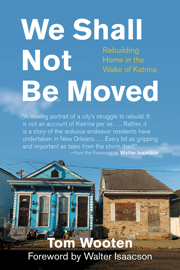We Shall Not Be Moved, by Tom Wooten. Beacon Press, 2012, 256pp, $25.95
Since Hurricanes Katrina and Rita devastated New Orleans and the Gulf Coast over seven years ago, a slew of books have charted the city’s recovery. Written from a range of vantage points, they have explored the various federal structures that failed the region, the role of climate change and environmental degradation, the intersections of poverty, race, and relief, and the various grassroots responses to the storm and its aftermath. With so much already written on New Orleans, it takes a fresh perspective to stand out from the crowd. Despite its admirable ambitions, We Shall Not Be Moved by Tom Wooten disappoints in its aims.
We Shall Not Be Moved is framed as the story of New Orleans’s rebuilding through the lens of five distinct neighborhoods—Broadmoor, Hollygrove, Holy Cross/the Lower Ninth Ward, Lakeview, and Village de l’Est. Fundamentally the book is a story of resilience, of the ability of communities to come together and create successful neighborhood-based planning initiatives when many thought these places couldn’t (or shouldn’t) return. While the stories collected from various residents by Wooten are indeed valuable and at times moving, there are questions about whom Wooten chose to tell the story of the city’s rebuilding.
Although over two-thirds of the city pre-Katrina was renters, and still approximately half of New Orleanians continue to rent, We Shall Not Be Moved relies too heavily on the narratives of New Orleans homeowners. There is nothing wrong in documenting the experiences of people who faced the challenge of rebuilding their private homes. However, it leads to a skewed portrait of the rebuilding process, while claiming to tell the city’s story broadly.
Central to this depiction is Wooten’s overreliance on neighborhood associations as the main agents of change during the reconstruction process. While many of the neighborhood associations he highlights have been rightfully nationally recognized for their work, neighborhood associations rarely represent an entire neighborhood. Their tendency to prioritize the experiences and desires of homeowners marginalizes the material issues facing neighbors who rent or live in publicly subsidized housing. By recounting the experiences of rebuilding primarily through the lens of neighborhood associations, Wooten never discusses the challenges facing non-homeowners in their attempts to return—from skyrocketing rents following the storm to the closure and eventual demolition of the majority of the city’s public housing. Additionally, even within his dependence on neighborhood associations, he primarily relies on the accounts of leaders, with little inclusion of the experiences of members who might have had a different perception of the events relayed.
Moreover, the neighborhoods Wooten chose to emphasize are predominately those that have been previously highlighted as exceptional rebuilding stories by journalists, academics, and filmmakers. His sole focus on these neighborhoods unintentionally contributes to narratives that suggest that neighborhoods that were able to successfully rebuild have done so solely because of their desires and hard work. Even when Wooten discusses the disproportionate resources many of these neighborhoods received via grants, technical assistance, and political connections, he implies these places had access to these resources because they were the most qualified without a broader analysis of macro and micro forces at play.
Though Wooten charts the problematic dynamics of the various citywide planning initiatives crafted by urban planners and developers, he otherwise ignores how other broader systems affected rebuilding. For example, almost every neighborhood discussed struggles to open a charter school. Yet, it is never mentioned that this is a result of the intentional dismantling of the city’s public school system in the wake of Katrina to make way for market-based educational reforms. His inability to situate individual stories within a broader framework misses the opportunity to explore how neighborhood associations have (or haven’t) negotiated the concerted, racialized project led by alliances between business interests and government actors to close down and privatize public infrastructure, particularly at the expense of working-poor and working class communities of color.
One argument Wooten does explicitly make is the importance of community-based planning that is directly accountable to residents. Such an analysis is crucially needed and is relevant not only to New Orleans but to other cities’ urban planning processes. Yet while discussing the role of outside organizations in supporting community planning, Wooten consistently holds up institutions such as Harvard University and AmeriCorps as positive examples, while implicitly criticizing locally based grassroots activist groups for having outside agendas. This binary framework fails to consider the messiness of national organizations’ implicit versus explicit agendas or the complex work of political organizing at both a neighborhood and city level.
Luckily there are several outstanding books and films that exist for those wanting to learn about the devastation, resistance, and recovery of New Orleans and what it means for the rest of the nation. Particularly excellent resources include the anthology Race, Place, and Environmental Justice after Hurricane Katrina, co-edited by Robert D. Bullard and Beverly Wright; Jordan Flaherty’s Floodlines: Community and Resistance from Katrina to the Jena Six, and the documentary Land of Opportunity, directed by Luisa Dantas.
In the end, We Shall Not Be Moved simplifies what has been a complicated, nuanced, and at times contradictory reconstruction process both within and across New Orleans neighborhoods. While laudable in its concentration on telling the story of the rebuilding from the grassroots up, the book’s lack of voices from those marginalized within neighborhoods combined with the absence of an analysis of systematic power provides for a narrow depiction of the rebuilding of the Crescent City.
[Correction: An earlier version of this review stated that the book relied entirely on the narratives of homeowners. This is not accurate, as one of the main characters the book follows is in fact a renter.]






I’ve written a response to Lydia’s review on the Shelterforce blog. You can access it here:
https://www.rooflines.org/3020/an_important_piece_of_the_puzzle_a_response_to_some_of_us_shall_not_be_move/